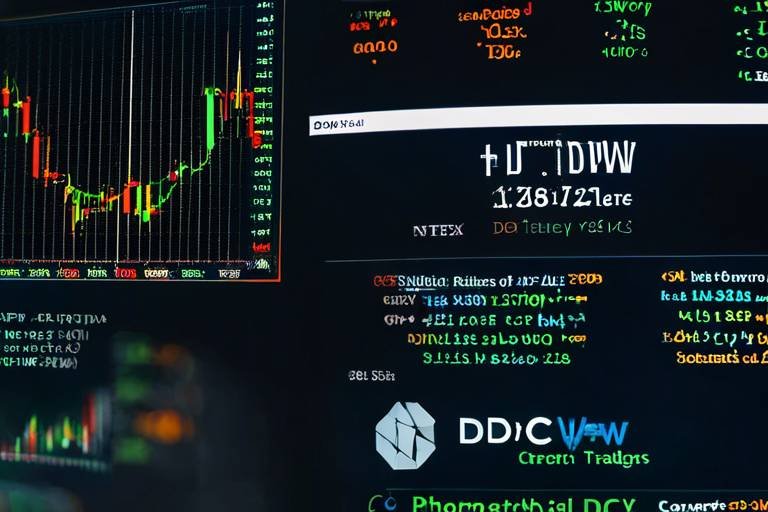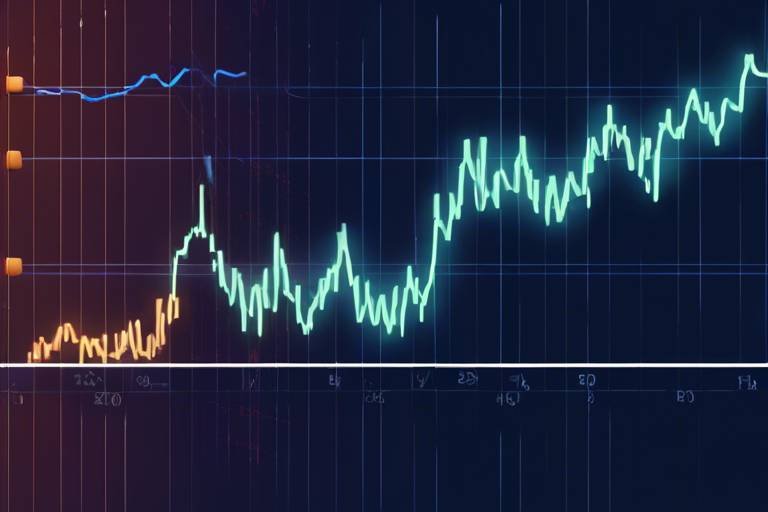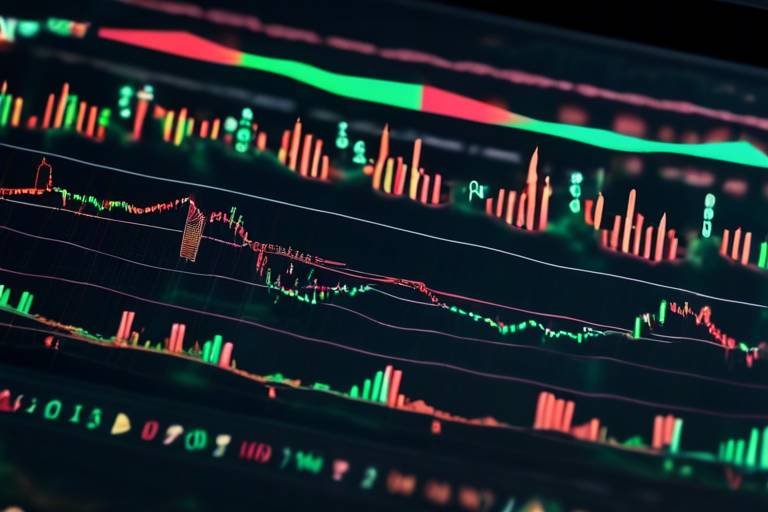Understanding the Dow Theory in Cryptocurrency Trading
Have you ever felt overwhelmed by the chaotic nature of cryptocurrency trading? You're not alone! Many traders find themselves lost in the sea of price fluctuations and market noise. That's where Dow Theory comes in. Developed in the late 19th century for stock markets, this theory has transcended its original purpose to become a vital tool for cryptocurrency traders. By understanding the principles of Dow Theory, you can navigate the tumultuous waters of the crypto market with greater confidence and clarity.
At its core, Dow Theory provides a framework for interpreting market trends and behaviors. It helps traders identify the direction of the market, recognize potential opportunities, and make informed decisions based on historical price movements. In the fast-paced world of cryptocurrency, where every second counts, having a solid understanding of these principles can be your secret weapon.
Imagine you're sailing a ship in unpredictable waters. The waves represent market volatility, and the wind symbolizes price movements. Dow Theory acts as your compass, guiding you toward safe harbors of profit while helping you avoid treacherous storms of loss. By applying its principles, you can enhance your trading strategies, manage your risks, and ultimately achieve long-term success.
In this article, we’ll dive deep into the key principles of Dow Theory and explore how they can be effectively applied in the cryptocurrency market. From understanding market trends and volume analysis to identifying bull and bear markets, we’ll cover it all. So, buckle up and get ready to transform your trading approach!

What is Dow Theory?
Dow Theory is a foundational framework that has stood the test of time, originally designed to analyze stock market trends. It was developed by Charles Dow, who co-founded Dow Jones & Company and created the first stock market index. At its core, Dow Theory seeks to understand and interpret market movements, providing valuable insights into the psychology of traders and investors.
This theory is particularly relevant in the realm of cryptocurrency trading, where the landscape is continually shifting and evolving. By applying the principles of Dow Theory, traders can better navigate the often turbulent waters of the cryptocurrency market. Essentially, it helps traders to identify patterns and trends that can indicate future price movements.
One of the most compelling aspects of Dow Theory is its emphasis on market cycles. It posits that markets move in predictable phases, which can be categorized into three main trends: primary, secondary, and minor. Understanding these trends allows traders to make more informed decisions, ultimately leading to better trading outcomes.
Moreover, Dow Theory highlights the importance of volume in confirming trends. In the cryptocurrency market, where volatility is the norm, high trading volumes can signal strong price movements, while low volumes might indicate a lack of conviction in the current trend. This insight is crucial for traders looking to capitalize on price fluctuations.
In summary, Dow Theory serves as a guiding light for traders in the cryptocurrency space, providing them with a structured approach to analyzing market behavior. By understanding its principles, traders can enhance their strategies and improve their chances of success in this fast-paced and often unpredictable market.

Key Principles of Dow Theory
The serve as the foundation for understanding market dynamics, not just in traditional stocks but also in the ever-evolving world of cryptocurrency trading. At its core, Dow Theory emphasizes the importance of market trends, phases, and volume analysis. By grasping these principles, traders can make more informed decisions and better navigate the complexities of the crypto landscape.
To start, let's delve into the concept of market trends. Dow Theory categorizes market movements into three distinct types: primary, secondary, and minor trends. Each of these trends plays a crucial role in shaping the overall market behavior. For instance, primary trends indicate the long-term direction of the market, whether it's bullish or bearish, while secondary trends provide insights into shorter-term price fluctuations. Understanding these trends is akin to reading a map; it helps traders chart their course through the often turbulent waters of cryptocurrency trading.
Next up is the phases of market trends. Every trend goes through three phases: accumulation, public participation, and distribution. During the accumulation phase, savvy investors buy assets when prices are low, setting the stage for the subsequent public participation phase, where the broader market jumps on board, driving prices up. Finally, in the distribution phase, those early investors begin to sell off their holdings, often leading to a market downturn. Recognizing these phases is essential for traders looking to maximize their profits and minimize losses.
Now, let’s talk about the importance of volume analysis. Volume refers to the number of assets traded within a specific period, and it serves as a powerful confirmation tool for trends. High trading volumes often validate price movements, indicating strong investor interest and commitment. Conversely, low volumes may suggest weak trends or a lack of conviction among traders. In cryptocurrency trading, where volatility can be extreme, understanding volume dynamics is crucial. For example, a price surge accompanied by high volume is generally more reliable than one with low volume, which might signal a potential reversal.
To illustrate these principles further, consider the following table that summarizes the key components of Dow Theory:
| Principle | Description |
|---|---|
| Market Trends | Identifies the overall direction of the market (primary, secondary, minor). |
| Phases of Trends | Includes accumulation, public participation, and distribution phases. |
| Volume Analysis | Confirms trends based on the number of assets traded. |
In conclusion, the are invaluable for anyone involved in cryptocurrency trading. By understanding market trends, recognizing the phases of those trends, and analyzing volume, traders can significantly enhance their decision-making processes. It's like having a compass in a dense forest; it provides direction and clarity in an otherwise chaotic environment. So, whether you're a seasoned trader or just starting, embracing these principles can elevate your trading strategy and potentially lead to greater success.
Q: Can Dow Theory be applied to short-term trading?
A: While Dow Theory is primarily focused on long-term trends, some principles can be adapted for short-term trading. However, traders should be cautious and consider other analysis methods.
Q: How do I identify the primary trend in cryptocurrency?
A: To identify the primary trend, observe the overall price movement over several months or years. Look for sustained increases or decreases in price to determine whether the market is in a bull or bear phase.
Q: Is volume analysis essential for cryptocurrency trading?
A: Yes, volume analysis is crucial. It helps confirm price movements and can indicate whether a trend is likely to continue or reverse.

Market Trends
Understanding is like having a map in a foreign land; it guides you through the complexities of cryptocurrency trading. Just as a ship navigates through different waters, traders must recognize the various trends that shape the market. In the world of cryptocurrencies, these trends are categorized into three distinct types: primary trends, secondary trends, and minor trends. Each of these trends plays a crucial role in how traders analyze and respond to market movements.
Let’s dive deeper into each of these trends. The primary trend is the overarching direction of the market, which can last from several months to even years. Think of it as the tide that lifts or lowers all boats; it sets the stage for everything else. Recognizing a primary trend can help traders identify whether the market is in a bullish (upward) or bearish (downward) phase. For instance, if the primary trend is upward, it might be a good time to consider buying, while a downward primary trend could signal a time to sell or short the market.
Next, we have secondary trends, which are shorter-term movements that occur within the primary trend. These trends can last from a few days to a few weeks and often represent corrections or rebounds within the larger trend. For example, during a primary bullish trend, a secondary trend might show a temporary dip in prices before resuming upward momentum. Understanding these fluctuations can provide traders with valuable opportunities to enter or exit positions at the right moment, maximizing profits and minimizing losses.
Lastly, there are minor trends, which are even shorter in duration and can last from a few hours to a few days. These trends are akin to the ripples on the surface of a lake; they can be influenced by various factors such as news events, market sentiment, or even social media trends. While minor trends might not have a significant impact on long-term trading strategies, they can offer quick trading opportunities for those inclined to engage in day trading or swing trading.
To summarize, recognizing the different types of market trends is essential for anyone looking to navigate the cryptocurrency landscape effectively. By understanding the interplay between primary, secondary, and minor trends, traders can make more informed decisions, ultimately leading to better trading outcomes. It's like having a keen sense of direction; when you know where the market is heading, you can position yourself to take advantage of the opportunities that arise.
As you delve deeper into cryptocurrency trading, keep these trends in mind. They are not just theoretical concepts; they are practical tools that can enhance your trading strategies. Whether you're a novice or a seasoned trader, mastering the art of trend analysis can make all the difference in achieving your trading goals.
- What is the primary trend in cryptocurrency?
The primary trend indicates the overall market direction, lasting several months to years, helping traders identify bullish or bearish phases. - How do secondary trends help traders?
Secondary trends provide insights into shorter-term price movements, allowing traders to make timely decisions to enter or exit positions. - What are minor trends and why are they important?
Minor trends are brief fluctuations that can offer quick trading opportunities, especially for day traders looking to capitalize on short-term movements.

Primary Trends
When diving into the world of cryptocurrency trading, understanding is like having a compass in a dense forest. These trends represent the overarching direction of the market, lasting anywhere from several months to even years. Think of primary trends as the big waves in the ocean; they dictate the overall flow and movement of the waters, while the smaller ripples (secondary trends) create temporary shifts. Recognizing these primary trends is crucial for traders, as it can help them identify potential bull markets (where prices are rising) and bear markets (where prices are falling).
To effectively grasp primary trends, traders often look for specific indicators, such as:
- Higher Highs and Higher Lows: In a bull market, prices consistently reach new highs and then pull back to higher lows, indicating a strong upward momentum.
- Lower Highs and Lower Lows: Conversely, in a bear market, the price action shows lower highs and lower lows, signaling a downward trend.
By identifying these patterns, traders can make more informed decisions about when to enter or exit the market. For example, if a trader notices that the price of Bitcoin has been consistently making higher highs, it might be a signal to consider buying, anticipating continued growth. On the flip side, if the price is showing lower highs, it could be time to reevaluate positions or even sell to minimize losses.
Moreover, primary trends can be influenced by various factors, including market sentiment, regulatory news, and technological advancements. It's essential for traders to stay informed about these external elements, as they can significantly affect the trajectory of primary trends. For instance, a major announcement regarding cryptocurrency regulation can shift the market sentiment, leading to a sudden change in trend direction.
In conclusion, recognizing and understanding primary trends in cryptocurrency trading is vital for anyone looking to navigate this volatile market effectively. By keeping an eye on the larger movements and understanding their implications, traders can position themselves better and potentially ride the waves of profit.
- What is a primary trend in cryptocurrency trading? A primary trend refers to the overall direction of the market, lasting several months to years, indicating whether the market is in a bull or bear phase.
- How can I identify a primary trend? Traders look for patterns such as higher highs and higher lows for bull markets, or lower highs and lower lows for bear markets.
- Why are primary trends important? Understanding primary trends helps traders make informed decisions about entry and exit points, maximizing potential profits and minimizing losses.
- Can external factors influence primary trends? Yes, elements like market sentiment, regulatory news, and technological advancements can significantly impact primary trends.

Secondary Trends
When diving into the world of cryptocurrency trading, understanding is like having a secret weapon in your trading arsenal. These trends are the short-term movements that occur within the larger primary trend, often lasting from a few days to several weeks. They can be likened to the ripples on a pond, reflecting the underlying currents of the primary trend. By analyzing these shorter fluctuations, traders can uncover golden opportunities to enter or exit positions, maximizing their potential gains.
Imagine you're surfing on a wave; the primary trend is the massive swell that powers your ride, while the secondary trends are the smaller waves that help you navigate through the water. Recognizing these smaller waves allows you to adjust your strategy and maintain balance amidst the chaos of the cryptocurrency market.
To effectively analyze secondary trends, traders can look for specific patterns and signals, such as:
- Price Corrections: These are temporary reversals in price movement that can indicate a potential entry point for traders looking to buy low.
- Consolidation Periods: When the price stabilizes after a movement, it often suggests that traders are gathering strength for the next big move.
- Volume Changes: An increase in trading volume during a secondary trend can validate the movement, signaling that the trend may continue.
Moreover, secondary trends can often signal shifts in market sentiment. For instance, if a cryptocurrency is experiencing a secondary upward trend while the primary trend is bearish, it may indicate a potential reversal or a temporary bullish sentiment among traders. This insight can be invaluable for those looking to make informed decisions in the fast-paced and often unpredictable world of cryptocurrency.
However, it’s crucial to remember that secondary trends can be deceptive. They can change direction quickly, leading traders to make hasty decisions based on short-term fluctuations. Therefore, combining secondary trend analysis with other indicators, such as technical analysis and market news, can provide a more comprehensive view of the market.
In summary, secondary trends are vital for traders who seek to capitalize on short-term price movements within the cryptocurrency market. By understanding these trends and their implications, traders can enhance their decision-making processes, ultimately leading to more successful trading outcomes.
- What are secondary trends in cryptocurrency trading? Secondary trends are short-term price movements that occur within the larger primary trend, lasting from days to weeks.
- How can I identify secondary trends? Traders can identify secondary trends by looking for price corrections, consolidation periods, and changes in trading volume.
- Why are secondary trends important? They provide opportunities for traders to enter or exit positions and can signal shifts in market sentiment.
- How do secondary trends relate to primary trends? Secondary trends occur within the context of the primary trend, reflecting shorter-term movements that can influence long-term trading strategies.

Volume Analysis
When it comes to trading cryptocurrencies, understanding is like having a secret weapon in your trading arsenal. It’s not just about the price movement; it’s about how many people are actually participating in that movement. Think of volume as the lifeblood of the market. If price is the heartbeat, then volume is the pulse that tells you whether that heartbeat is strong or weak.
High trading volume often indicates a strong trend, as it suggests that a significant number of traders are buying or selling, which can validate the price movement. For instance, if Bitcoin’s price surges from $30,000 to $35,000 on high volume, it signals that many traders believe this upward movement is legitimate. On the flip side, if the price rises on low volume, it might be a sign of a fake-out—an illusion of strength that could lead to a sudden reversal.
To illustrate this point, let’s take a look at a simple table that highlights the relationship between price changes and volume:
| Price Movement | Volume Level | Market Sentiment |
|---|---|---|
| Price Increase | High | Strong Bullish Sentiment |
| Price Increase | Low | Weak Bullish Sentiment |
| Price Decrease | High | Strong Bearish Sentiment |
| Price Decrease | Low | Weak Bearish Sentiment |
Additionally, volume can help traders identify potential reversals. For example, if a cryptocurrency has been on a downward trend for a while, but suddenly experiences a spike in volume as the price starts to stabilize, this could indicate that traders are beginning to buy in, which might lead to a price reversal. In essence, volume acts as a confirmation tool, giving traders the confidence to make informed decisions.
Moreover, it’s essential to consider the context of volume. What might be considered high volume in one market might be deemed low in another. Therefore, traders should always compare current volume levels with historical data to gauge whether the current activity is significant. This comparative analysis can provide deeper insights into market behavior, enabling traders to make more educated decisions.
In conclusion, mastering volume analysis is crucial for any cryptocurrency trader. It not only enhances the understanding of market dynamics but also assists in making strategic decisions. By keeping a close eye on volume trends, traders can better navigate the unpredictable waters of cryptocurrency trading, potentially leading to greater profits and reduced risks.
- What is the significance of volume in cryptocurrency trading?
Volume provides insights into the strength of price movements. High volume often indicates strong trends, while low volume can signal weak trends or potential reversals.
- How can I analyze volume effectively?
Compare current volume levels with historical data and observe price movements alongside volume spikes to identify potential trading opportunities.
- Can volume analysis predict market reversals?
Yes, sudden spikes in volume can indicate that traders are changing their positions, which may lead to market reversals.

Application of Dow Theory in Cryptocurrency
Applying Dow Theory to the realm of cryptocurrency trading can seem daunting at first, but once you grasp the core concepts, it becomes a powerful tool for navigating the tumultuous waters of the crypto market. The essence of Dow Theory lies in recognizing and interpreting market trends, which can significantly enhance your trading strategies. By analyzing historical price data, traders can identify patterns that may repeat, allowing for more informed decision-making. Think of it like using a map to navigate through a dense forest; it helps you avoid pitfalls and find the best paths to your destination.
One of the primary applications of Dow Theory in cryptocurrency is the identification of bull and bear markets. A bull market is characterized by rising prices and investor optimism, while a bear market signifies falling prices and widespread pessimism. By understanding these market phases, traders can strategically position themselves to either capitalize on upward trends or protect their investments during downturns. For example, during a bull market, a trader might consider increasing their exposure to cryptocurrencies, while in a bear market, they might focus on minimizing losses or even short-selling.
Another essential aspect of applying Dow Theory is the incorporation of risk management strategies. The unpredictable nature of cryptocurrency markets necessitates a robust approach to risk management. Traders can utilize principles from Dow Theory to set stop-loss orders, which automatically sell a cryptocurrency when it reaches a certain price, thereby limiting potential losses. Additionally, diversifying investments across multiple cryptocurrencies can help mitigate risks associated with market volatility. Here’s a brief overview of effective risk management strategies:
| Strategy | Description |
|---|---|
| Stop-Loss Orders | Automatically sells a cryptocurrency at a predetermined price to limit losses. |
| Diversification | Spreading investments across various cryptocurrencies to reduce risk. |
| Position Sizing | Determining the amount of capital to allocate to each trade based on risk tolerance. |
Moreover, understanding volume dynamics is crucial when applying Dow Theory to cryptocurrency trading. Volume can act as a confirming indicator of trends. For instance, if a cryptocurrency is experiencing a price increase accompanied by high trading volume, it suggests strong buying interest and can confirm the validity of the upward trend. Conversely, if prices are rising but volume is low, it may indicate a lack of conviction, suggesting that the trend could reverse. Therefore, keeping an eye on volume alongside price movements can significantly enhance your trading decisions.
In summary, the application of Dow Theory in cryptocurrency trading is about more than just recognizing trends; it’s about integrating those insights into a comprehensive trading strategy. By identifying market phases, employing effective risk management techniques, and analyzing volume, traders can navigate the volatile cryptocurrency landscape with greater confidence and precision. Remember, the crypto market is a wild ride, but with the right tools and knowledge, you can steer your ship through the storm!
Q1: Can Dow Theory be applied to short-term trading in cryptocurrency?
A1: While Dow Theory is more effective for long-term trends, some principles can be adapted for short-term trading. However, traders should combine it with other analysis methods for better results.
Q2: What is the best way to start applying Dow Theory?
A2: Begin by studying historical price charts of cryptocurrencies, identifying primary and secondary trends, and practicing risk management strategies based on your findings.
Q3: Are there any specific cryptocurrencies where Dow Theory works better?
A3: Dow Theory can be applied to any cryptocurrency, but its effectiveness may vary based on market conditions and the specific characteristics of the asset.

Identifying Bull and Bear Markets
In the world of cryptocurrency trading, identifying bull and bear markets is crucial for making informed decisions that can significantly impact your trading success. But what do these terms really mean? A bull market is characterized by rising prices and investor confidence, while a bear market features declining prices and a general sense of pessimism. Understanding these market conditions can help traders position themselves effectively, whether they are looking to capitalize on upward trends or protect their investments during downturns.
To identify these market conditions, traders often look for specific indicators and patterns. One of the most effective methods is to analyze price movements over time. For instance, if you notice that the price of a cryptocurrency consistently makes higher highs and higher lows, you may be in a bull market. Conversely, if the price is making lower highs and lower lows, it's likely a bear market. This simple yet effective observation can serve as a foundation for your trading strategy.
Another key aspect to consider is market sentiment. Tools like social media analysis and news sentiment can give you insights into how traders feel about a particular cryptocurrency. For example, a surge in positive news coverage or social media buzz can indicate the start of a bull market. On the other hand, negative news or widespread fear can signal a bear market. By monitoring these sentiments, you can better anticipate market movements.
Volume is another critical factor in identifying bull and bear markets. High trading volumes during price increases can confirm that a bull market is gaining momentum, while low volumes during price declines may suggest a lack of conviction in a bear market. Therefore, keeping an eye on trading volumes can provide additional confirmation of the prevailing market trend.
To summarize, here are some key indicators to help you identify bull and bear markets:
- Price Patterns: Look for higher highs and higher lows for bull markets; lower highs and lower lows for bear markets.
- Market Sentiment: Analyze news and social media to gauge trader sentiment.
- Volume Analysis: High volumes during price increases indicate a strong bull market, while low volumes during declines suggest a weak bear market.
By combining these indicators, you can develop a clearer picture of the market landscape. This understanding not only helps you make better trading decisions but also enhances your ability to manage risks effectively. Remember, the cryptocurrency market is notorious for its volatility, and being able to identify these market phases can give you a significant edge over less informed traders.

Risk Management Strategies
When it comes to cryptocurrency trading, the old adage “don’t put all your eggs in one basket” rings especially true. Risk management is not just a strategy; it’s a necessity in this volatile environment. By implementing effective risk management strategies based on the principles of Dow Theory, traders can protect their investments and enhance their chances of long-term success.
One of the most effective risk management techniques is the use of stop-loss orders. A stop-loss order allows traders to set a predetermined price at which their asset will be sold to prevent further losses. For example, if a trader purchases Bitcoin at $40,000 and sets a stop-loss order at $38,000, the order will automatically execute if the price drops to that level. This helps to limit losses without the need for constant monitoring of the market.
Another key strategy is to diversify your portfolio. In the world of cryptocurrency, this means not only investing in multiple coins but also in different sectors within the crypto space. By spreading investments across various cryptocurrencies—such as Bitcoin, Ethereum, and emerging altcoins—traders can mitigate the risks associated with any single asset. This diversification can act as a buffer against market volatility.
Additionally, understanding your risk tolerance is vital. Each trader has a different level of comfort when it comes to potential losses. By assessing personal risk tolerance, traders can determine how much capital they are willing to risk on each trade. A common recommendation is to risk no more than 1-2% of your total trading capital on a single trade. This way, even in the event of a series of losses, your overall portfolio remains intact.
| Risk Management Strategy | Description |
|---|---|
| Stop-Loss Orders | Automatically sell an asset at a predetermined price to limit losses. |
| Diversification | Invest in multiple cryptocurrencies to spread risk. |
| Risk Tolerance Assessment | Determine how much capital to risk on each trade based on personal comfort levels. |
Moreover, it’s important to develop a solid trading plan that outlines entry and exit points based on Dow Theory principles. This plan should include guidelines for when to take profits and when to cut losses. Sticking to this plan can help eliminate emotional decision-making, which often leads to poor trading outcomes.
Lastly, continuous education is key in the ever-evolving cryptocurrency landscape. Staying updated on market trends, technological advancements, and regulatory changes can provide traders with insights that enhance their risk management strategies. By combining knowledge with Dow Theory, traders can navigate the unpredictable waters of cryptocurrency with greater confidence.
- What is a stop-loss order? A stop-loss order is an instruction to sell a cryptocurrency when it reaches a certain price, helping to limit losses.
- How much should I risk on each trade? It is generally recommended to risk no more than 1-2% of your total trading capital on a single trade.
- Why is diversification important? Diversification helps mitigate risk by spreading investments across different cryptocurrencies and sectors.
- How can I improve my trading plan? Continuously educate yourself on market trends and adjust your trading plan based on your experiences and the principles of Dow Theory.

Limitations of Dow Theory
While Dow Theory offers a robust framework for analyzing market trends, it is not without its limitations, especially in the rapidly evolving landscape of cryptocurrency trading. One of the most significant drawbacks is the inherent market volatility associated with cryptocurrencies. Unlike traditional stocks, which may exhibit more stable price movements, cryptocurrencies can experience drastic fluctuations within short time frames. This volatility can lead to situations where Dow Theory's predictions fail to align with actual price movements, causing traders to make decisions based on outdated or inaccurate signals.
Moreover, time frame differences can also impact the effectiveness of Dow Theory. For instance, long-term investors may find the principles of Dow Theory quite useful for identifying overarching trends and making strategic decisions. However, short-term traders, who thrive on quick trades and rapid market changes, might find Dow Theory less applicable. The theory is inherently designed to capture longer-term trends, which can leave short-term traders at a disadvantage if they rely solely on its principles.
Another important aspect to consider is that Dow Theory does not account for external factors that can significantly influence cryptocurrency prices. Events such as regulatory changes, technological advancements, or major news stories can rapidly alter market dynamics. Therefore, while Dow Theory can provide a solid foundation for analysis, it should be used in conjunction with other methods and tools. This multi-faceted approach can help traders navigate the complexities of the cryptocurrency market more effectively.
To summarize, here are some of the key limitations of Dow Theory in cryptocurrency trading:
- Market Volatility: Cryptocurrencies can experience extreme price fluctuations that may not align with Dow Theory predictions.
- Time Frame Differences: The theory is more applicable to long-term trends, making it less useful for short-term traders.
- External Influences: Dow Theory does not consider external factors like regulatory changes or major news events that can impact prices.
Incorporating these considerations into your trading strategy can help you make more informed decisions and potentially enhance your success in the unpredictable world of cryptocurrency.
What is Dow Theory?
Dow Theory is a framework for understanding market trends and behaviors, originally developed for stock trading, which can also be applied to cryptocurrency trading.
How can I apply Dow Theory to cryptocurrency trading?
You can apply Dow Theory by recognizing market trends and making informed decisions based on historical price data, which can enhance your trading strategies and risk management.
What are the key principles of Dow Theory?
The key principles include understanding market trends, phases, and the importance of volume in confirming price movements.
What are the limitations of Dow Theory in cryptocurrency trading?
Some limitations include market volatility, time frame differences, and the lack of consideration for external factors that can influence cryptocurrency prices.

Market Volatility
The world of cryptocurrency trading is notoriously known for its extreme volatility. Unlike traditional markets, where fluctuations can be measured in steady increments, the crypto landscape often resembles a rollercoaster ride, with prices soaring and plummeting in a matter of minutes. This unpredictability can be thrilling for traders but also poses significant risks. Understanding market volatility is essential for anyone looking to navigate the turbulent waters of cryptocurrency.
One of the primary reasons for this volatility is the speculative nature of cryptocurrencies. Many traders are driven by emotions such as fear and greed, leading to rapid buying and selling that can cause drastic price changes. For instance, a single tweet from a prominent figure can send a cryptocurrency's price skyrocketing or crashing down. This phenomenon highlights the importance of staying informed and being prepared for sudden market shifts.
Moreover, the liquidity of the cryptocurrency market can contribute to its volatility. Unlike traditional assets that have a vast pool of buyers and sellers, cryptocurrencies often have lower trading volumes, especially for lesser-known coins. This means that even a relatively small trade can have a significant impact on the price. To illustrate this, consider the following table:
| Cryptocurrency | Average Daily Volume | Price Movement (24h) |
|---|---|---|
| Bitcoin | $30 billion | ±5% |
| Ethereum | $20 billion | ±7% |
| Dogecoin | $1 billion | ±15% |
As shown in the table, Dogecoin, with a significantly lower average daily volume compared to Bitcoin and Ethereum, can experience much higher price fluctuations. This exemplifies how liquidity plays a crucial role in determining market stability.
In addition to these factors, external events such as regulatory news, technological advancements, or security breaches can further exacerbate volatility. For example, when a major exchange gets hacked, it can lead to panic selling across the market, causing prices to drop sharply. Traders must remain vigilant and adaptable, ready to respond to news and events that can impact their investments.
While volatility can present opportunities for profit, it also necessitates a robust risk management strategy. Traders should consider setting stop-loss orders to limit potential losses and avoid emotional trading decisions. Additionally, diversifying their portfolios across different cryptocurrencies can help mitigate risks associated with individual asset volatility.
In summary, understanding market volatility is crucial for cryptocurrency traders. By recognizing the factors that contribute to price fluctuations and implementing effective risk management strategies, traders can navigate this unpredictable market more successfully. After all, in the world of crypto, staying informed and prepared is key to thriving amidst the chaos.
- What causes cryptocurrency volatility? Cryptocurrency volatility is primarily driven by speculation, market sentiment, liquidity, and external events.
- How can I manage risks associated with volatility? Implementing stop-loss orders, diversifying your portfolio, and staying informed about market news can help manage risks.
- Is volatility a good thing for traders? While volatility can present opportunities for profit, it also increases the risk of significant losses, so traders must exercise caution.

Time Frame Differences
When it comes to trading cryptocurrencies, the time frame you choose can significantly impact your strategy and decision-making. Dow Theory, while a robust framework for understanding market trends, may not be equally effective across all time frames. For instance, long-term investors often find Dow Theory to be a valuable tool, as it helps them identify overarching trends that can span months or even years. This perspective allows them to ride the waves of the market, capitalizing on significant price movements that align with the primary trends.
On the other hand, short-term traders, who thrive on quick trades and rapid market fluctuations, might find Dow Theory less applicable. The fast-paced nature of the cryptocurrency market can lead to sudden price shifts that may not align with the longer-term trends identified by Dow Theory. In such cases, relying solely on this theory could result in missed opportunities or, worse, significant losses. Therefore, it's crucial for short-term traders to integrate other analytical methods, such as technical analysis or momentum indicators, to complement the insights provided by Dow Theory.
To illustrate the differences in effectiveness based on time frames, consider the following table:
| Time Frame | Application of Dow Theory | Recommended Strategies |
|---|---|---|
| Long-Term (Months to Years) | Highly applicable for identifying primary trends. | Buy and hold strategies, trend-following. |
| Medium-Term (Weeks to Months) | Useful for recognizing secondary trends. | Swing trading, trend reversals. |
| Short-Term (Days to Weeks) | Less applicable; may not capture rapid price movements. | Scalping, day trading, using additional indicators. |
Ultimately, understanding these time frame differences is essential for traders aiming to optimize their strategies in the cryptocurrency market. By aligning your trading approach with the appropriate time frame, you can enhance your decision-making process and improve your chances of success. So, whether you're a seasoned investor or a newbie just dipping your toes into the crypto waters, keep in mind that the time frame you choose can make all the difference!
- What is the best time frame for trading cryptocurrencies? The best time frame depends on your trading style. Long-term investors might prefer monthly or weekly charts, while day traders often use hourly or minute charts.
- Can Dow Theory be applied to all cryptocurrencies? Yes, Dow Theory can be applied to any cryptocurrency, but its effectiveness may vary based on market conditions and the specific coin's volatility.
- How can I combine Dow Theory with other analysis methods? You can use technical indicators, chart patterns, and fundamental analysis alongside Dow Theory to create a more comprehensive trading strategy.
Frequently Asked Questions
- What is Dow Theory and how does it apply to cryptocurrency trading?
Dow Theory is a framework that helps traders understand market trends and behaviors. Originally developed for stock trading, it provides insights into market cycles and price movements, making it applicable to cryptocurrency trading as well. By recognizing patterns in price data, traders can make more informed decisions.
- How can I identify primary and secondary trends in the cryptocurrency market?
To identify primary trends, look for the overall direction of the market over several months to years, which can indicate potential bull or bear markets. Secondary trends, on the other hand, are shorter-term movements within these primary trends. Analyzing charts and historical data can help you spot these trends effectively.
- Why is volume analysis important in cryptocurrency trading?
Volume analysis is crucial because it helps confirm trends. High trading volumes can validate price movements, signaling strong market interest, while low volumes may suggest weak trends. Understanding volume dynamics allows traders to gauge the strength of a price movement, making it a key component of successful trading strategies.
- What are some risk management strategies when using Dow Theory?
Implementing risk management strategies involves setting stop-loss orders, diversifying your portfolio, and only investing what you can afford to lose. By applying Dow Theory principles, traders can better anticipate market movements and protect their investments in the unpredictable cryptocurrency landscape.
- What are the limitations of Dow Theory in cryptocurrency trading?
While Dow Theory offers valuable insights, it has limitations, especially in the highly volatile cryptocurrency market. Price movements can be unpredictable, so it's essential to combine Dow Theory with other analysis methods. Additionally, the effectiveness of Dow Theory can vary based on the time frame you choose for your trades.
- Can Dow Theory be used for short-term trading?
Dow Theory is primarily suited for long-term trading due to its focus on identifying primary trends. Short-term traders may find it less applicable, but they can still benefit from understanding the broader market context it provides. It's essential to adapt your trading strategy based on your investment goals and time frame.



















